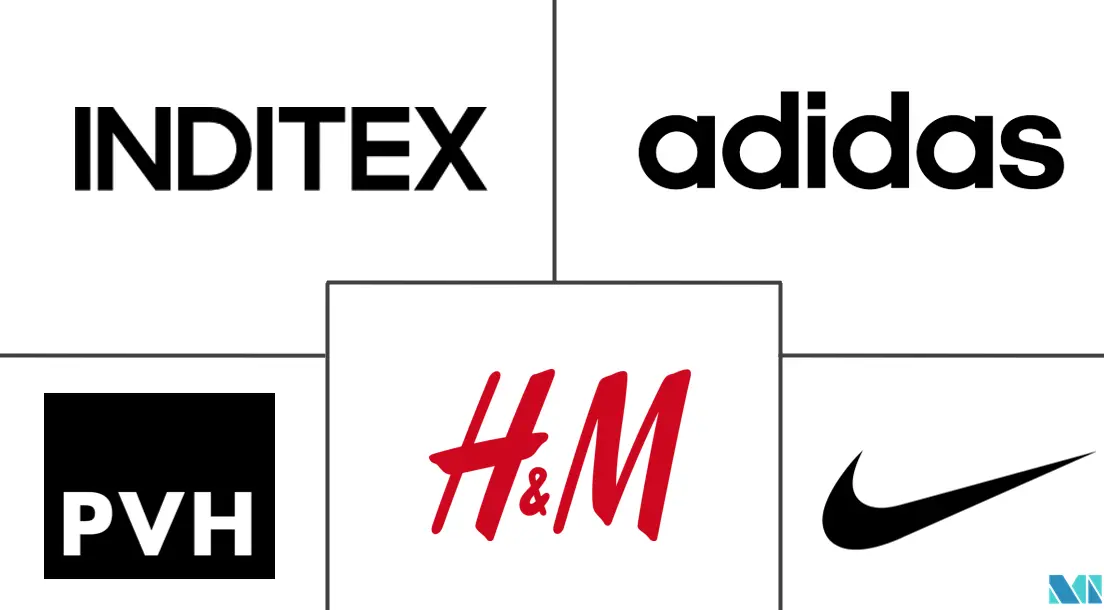South America E-Commerce Apparel Market Size and Share
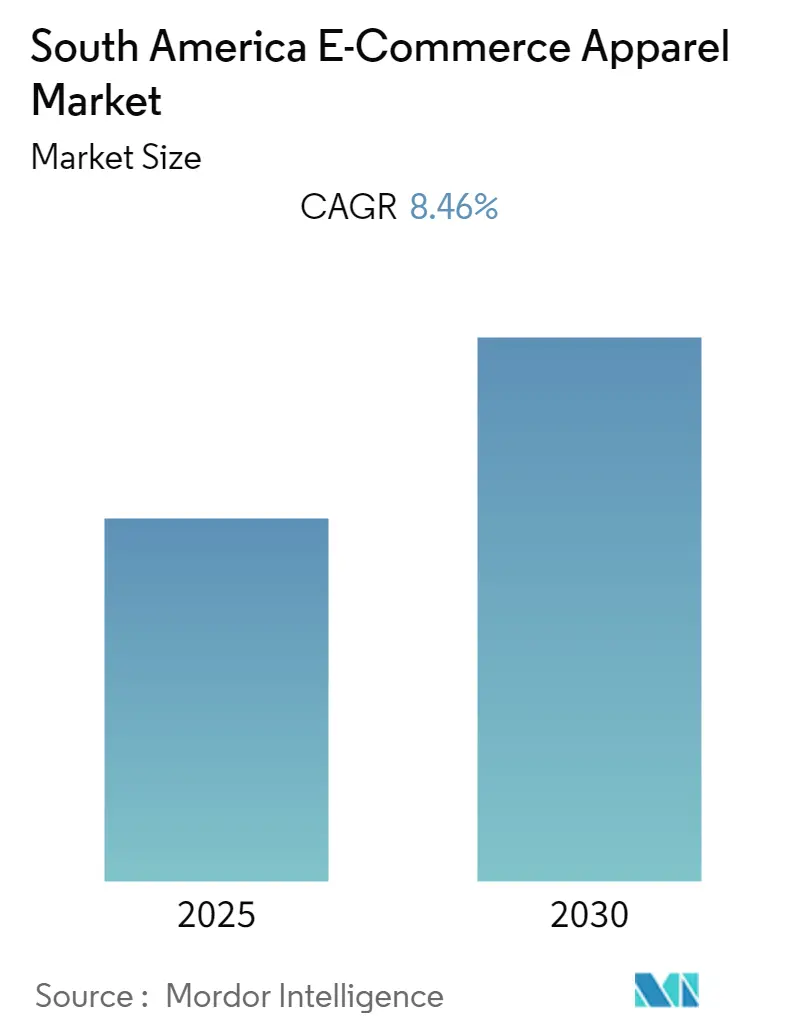
South America E-Commerce Apparel Market Analysis by Mordor Intelligence
The South America E-Commerce Apparel Market is expected to register a CAGR of 8.46% during the forecast period.
- >
- The growth of social media in the region has had a significant impact, especially on millennials, affecting their purchasing behavior via social media platforms and internet channels. Thus, the sales of apparel through online stores have witnessed rapid growth in recent years owing to the level of convenience that it provides for consumers. Furthermore, e-commerce platforms are gaining market share in terms of revenue, popularity, and a diverse range of products from both local and worldwide brands.
- According to Fundação Getúlio Vargas, in 2021, Lojas Renner was the top-performing fashion shop in Brazil, with net sales of over BRL 10.5 billion. Guararapes Online, a clothing and accessory company, had net sales of almost BRL 7 billion (USD 1.26 billion) that year, making it the second retailer in the country's fashion industry. This instance advocates the growth of the e-commerce apparel industry across the region.
- Online retail stores have been growing in popularity as the platform offers the ease of buying from the comfort of one's home, as well as product descriptions, a questionnaire regarding sizes, a more thorough selection of different brands, and a greater diversity of materials, patterns, and no capital requirement for setting up a store like in case of supermarkets or specialty stores. Hence, the players offering apparel across the region have been exploring the e-commerce retail space to gain major market shares in the market studied. For instance, in 2021, Calvin Klein, a subsidiary of PVH Corp., announced the launch of its e-commerce in Peru. This launch marks the latest addition to the growing Calvin Klein e-commerce portfolio across South America and gives customers across the region access to shop online for men's and women's apparel offerings. Hence, the availability of various brands on the e-commerce platforms and other factors such as the time-saving viewpoint, easy-to-navigate online shopping portals, hassle-free online payments, and in-home delivery is expected to be rising and are expected to boost the e-commerce apparel market across the region.
South America E-Commerce Apparel Market Trends and Insights
Increased Influence of Social Media and Aggressive Marketing
- The apparel business across South America has been one of the most positively impacted businesses due to social media. It provides marketers with a wide range of tools to establish a personalized, interactive connection with target customers. The apparel brands that have a presence on social media platforms also provide online users with their digital catalogs and launch various campaigns, which help the clothing brands to improve their brand recognition and e-commerce sales across the region.
- For example, in February 2023, the "Welcome to the Third Academy" or "Bem-vindos à Terceira Academia" marketing campaign was launched by PUMA Brazil and Palmeiras to introduce the new HOME and AWAY shirts for the 2023 season. The campaign was also launched on Instagram, which is a popular social media platform being used across the region. Hence, various brands have been entering the social media space to attract the attention of various customers. For instance, Hypebeast, a media and lifestyle brand, launched its Brazilian social media channel- Hypebeast Brasil, in February 2022. The company offers a wide range of apparel collections in its fashion segment.
- Different cutting-edge techniques for large players' social media presence are made possible by various social media platforms. In this context, Instagram has flourished as a leading social media channel for apparel companies. As per World Bank data, the percentage of the population using the internet across Argentina rose to 87% in 2021. Increased internet usage has led to the exposure of customers across the region to various social media platforms and ad campaigns, and it has also led to access to different e-commerce websites. Hence, the increased internet usage and social media influence are expected to drive the market shortly.
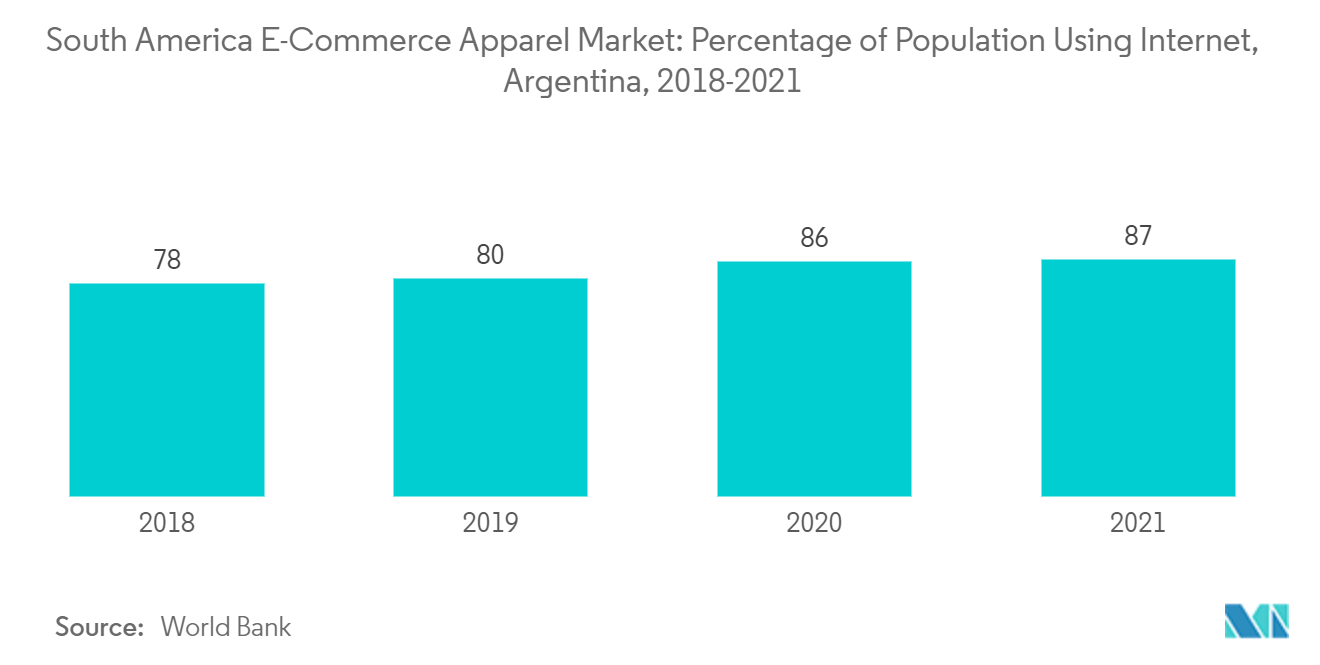
Brazil Dominates the Market Across the Region
- Brazil has been the dominant country in the South American e-commerce apparel market. With factors such as growing job creation, increased disposable income, and evolving fashion trends, the market for e-commerce apparel has been growing in Brazil over the review period. A recent trend seen in Brazil was a boom in athleisure as consumers swapped business casual and professional apparel for yoga pants and t-shirts. Brands such as Lululemon, Athleta, Calvin Klein, Tommy Hilfiger, and Dick's Sporting Goods reported strong sales for athleisure attire over the past few years.
- Hence, the players offering sportswear have been expanding their omnichannel distribution across the region. For example, in February 2020, Nike Inc. in Brazil, Argentina, Chile, and Uruguay announced their plans to strategic distributor agreements, enabling a more lucrative, capital-efficient, and value-adding business model, according to NIKE, Inc. The partnership plans also included collaboration with third-party e-commerce retailers across the region. This indicates the growth of the e-commerce apparel market across the region.
- Online sales have been thriving across the region owing to the development in the e-commerce channels and the convenience of purchase offered by them. According to the Brazilian Institute of Geography and Statistics, online sales accounted for 10.14% of the retail sales in Brazil, which was higher as compared to the percentage during the previous year, which was 9.14% in the year 2021. Hence, the increased acceptance of e-commerce channels is expected to drive the market studied across Brazil during the forecast period.
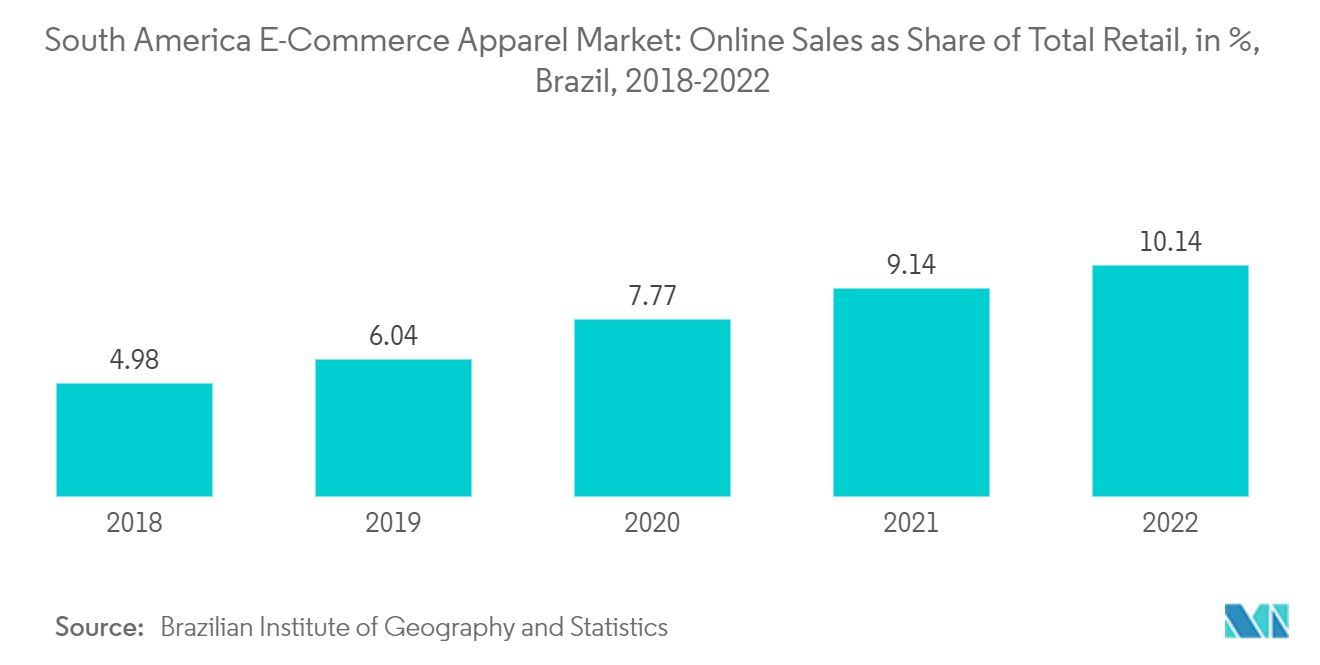
Competitive Landscape
The South America E-Commerce Apparel Market is highly fragmented, with the presence of several players offering their products via various e-commerce websites across the region. The top players in the market studied include H & M Hennes & Mauritz AB, PVH Corp., Adidas AG, Nike Inc., and Industria de Diseño Textil, S.A. (INDITEX). Companies are increasing their investments in research and development (R&D) and marketing and are expanding their presence across various e-commerce platforms to maintain their position in the market.
These leading companies have an extensive product portfolio in the apparel market that is being offered through various online stores. For instance, Lojas Riachuelo's website in Brazil offers apparel from different brands, including Levis, Carter's, Tommy Hilfiger, and others. Additionally, economies of scale and high brand loyalty among consumers give these companies an upper edge. Further expansion of product portfolio within all categories is projected to enhance the companies' positions in the market.
South America E-Commerce Apparel Industry Leaders
-
PVH Corp.
-
Adidas AG
-
H & M Hennes & Mauritz AB
-
Nike Inc
-
Industria de Diseño Textil, S.A. (INDITEX)
- *Disclaimer: Major Players sorted in no particular order
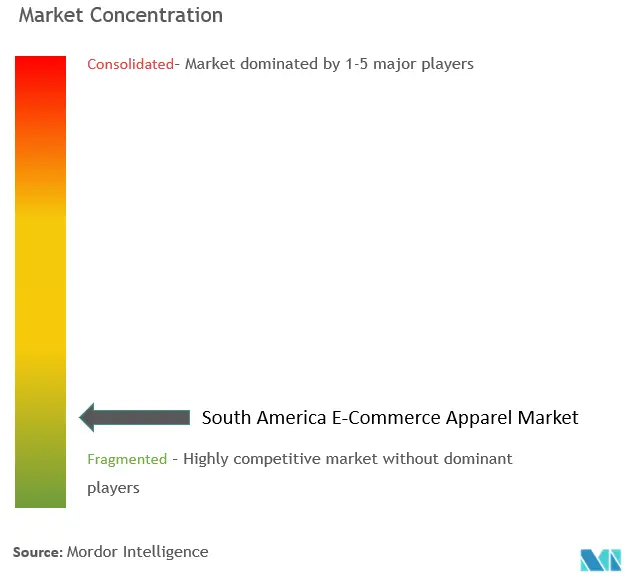
Recent Industry Developments
- February 2023: PVH Corp announced the launch of the Calvin Klein affiliate program, a popular e-commerce affiliate program. The company offers e-retailers across Brazil an offer to join the Calvin Klein Affiliate Marketing Campaign and claims that on joining the program, the visitors of the e-commerce sites have access to online stores in Brazil.
- August 2022: H&M announced the launch of its online store uy.hm.com in Uruguay, with this launch. The online store offered apparel collections for men, women, and kids. The first H&M store in Uruguay was opened in the year 2018, and uy.hm.com was H&Ms 57th online market in the region.
- September 2021: Popular football player Neymar Jr. partnered with Puma to launch his lifestyle collection. The lifestyle collection featured a range of footwear, including PUMA's newest Wild Rider franchise, apparel pieces like hoodies, bombers, t-shirts, and cargo pants, along with a selection of accessories, beanies, caps, and a backpack.
South America E-Commerce Apparel Market Report Scope
Apparel, also known as clothing, can be defined as garments that are worn on the body. E-commerce apparel refers to the buying and selling of fashion and apparel products online, specifically through e-commerce platforms.
The South America E-commerce Apparel Market is segmented by product type, end-user, platform type, and geography. Based on product type, the market is segmented into formal wear, casual wear, sportswear, nightwear, and other types. By end user, the market is segmented into men, women, and kids/children. The market is segmented by platform type into third-party retailers and the company's own website. The study also covers the regional-level analysis of the major countries, including Brazil, Argentina, and the Rest of South America.
The market sizing has been done in value terms in USD for all the abovementioned segments.
| Formal Wear |
| Casual Wear |
| Sportswear |
| Nightwear |
| Other Types |
| Men |
| Women |
| Kids/Children |
| Third Party Retailer |
| Company's Own Website |
| Brazil |
| Argentina |
| Rest of South America |
| Product Type | Formal Wear |
| Casual Wear | |
| Sportswear | |
| Nightwear | |
| Other Types | |
| End User | Men |
| Women | |
| Kids/Children | |
| Platform Type | Third Party Retailer |
| Company's Own Website | |
| Geography | Brazil |
| Argentina | |
| Rest of South America |
Key Questions Answered in the Report
What is the current undefined size?
The undefined is projected to register a CAGR of 8.46% during the forecast period (2025-2030)
Who are the key players in undefined?
PVH Corp., Adidas AG, H & M Hennes & Mauritz AB, Nike Inc and Industria de Diseño Textil, S.A. (INDITEX) are the major companies operating in the undefined.
What years does this undefined cover?
The report covers the undefined historical market size for years: 2019, 2020, 2021, 2022, 2023 and 2024. The report also forecasts the undefined size for years: 2025, 2026, 2027, 2028, 2029 and 2030.
Page last updated on:
South America E-Commerce Apparel Market Report
Statistics for the 2025 South America E-Commerce Apparel market share, size and revenue growth rate, created by Mordor Intelligence™ Industry Reports. South America E-Commerce Apparel analysis includes a market forecast outlook for 2025 to 2030 and historical overview. Get a sample of this industry analysis as a free report PDF download.
